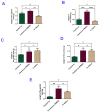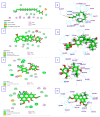Enhancement of Female Rat Fertility via Ethanolic Extract from Nigella sativa L. (Black Cumin) Seeds Assessed via HPLC-ESI-MS/MS and Molecular Docking
- PMID: 38338478
- PMCID: PMC10856701
- DOI: 10.3390/molecules29030735
Enhancement of Female Rat Fertility via Ethanolic Extract from Nigella sativa L. (Black Cumin) Seeds Assessed via HPLC-ESI-MS/MS and Molecular Docking
Abstract
The characteristic chemical composition of Nigella seeds is directly linked to their beneficial properties. This study aimed to investigate the phytochemical composition of Nigella sativa seeds using a 100% ethanolic extract using HPLC-ESI-MS/MS. Additionally, it explored the potential biological effects of the extract on female rat reproduction. Follicle Stimulating Hormone (FSH), Luteinizing Hormone (LH), Estrogen (E2), and Progesterone (P4) hormone levels were also assessed, along with the morphological and histological effects of the extract on ovarian, oviductal, and uterine tissues. Molecular docking was performed to understand the extract's activity and its role in regulating female reproduction by assessing its binding affinity to hormonal receptors. Twenty metabolites, including alkaloids, saponins, terpenes, flavonoids, phenolic acids, and fatty acids, were found in the ethanolic extract of N. sativa seeds through the HPLC-ESI-MS/MS study. The N. sativa seed extract exhibited strong estrogenic and LH-like activities (p < 0.05) with weak FSH-like activity. Furthermore, it increased the serum levels of LH (p < 0.05), P4 hormones (p < 0.001), and E2 (p < 0.0001). Molecular docking results displayed a strong interaction with Erβ, LH, GnRH, and P4 receptors, respectively. Based on these findings, N. sativa seeds demonstrated hormone-like activities, suggesting their potential as a treatment for improving female fertility.
Keywords: E2 hormones; FSH; HPLC-ESI-MS/MS; LH; Nigella sativa; molecular docking.
Conflict of interest statement
The authors declare no conflicts of interest.
Figures








Similar articles
-
Comparative Studies on Polyphenolic Composition, Antioxidant and Diuretic Effects of Nigella sativa L. (Black Cumin) and Nigella damascena L. (Lady-in-a-Mist) Seeds.Molecules. 2015 May 26;20(6):9560-74. doi: 10.3390/molecules20069560. Molecules. 2015. PMID: 26016547 Free PMC article.
-
Phytochemical Profile and Antioxidant Activity of Nigella sativa L Growing in Morocco.ScientificWorldJournal. 2021 Apr 20;2021:6623609. doi: 10.1155/2021/6623609. eCollection 2021. ScientificWorldJournal. 2021. PMID: 33986636 Free PMC article.
-
Evaluation of phenolic profile, enzyme inhibitory and antimicrobial activities of Nigella sativa L. seed extracts.Bosn J Basic Med Sci. 2017 Nov 20;17(4):286-294. doi: 10.17305/bjbms.2017.2049. Bosn J Basic Med Sci. 2017. PMID: 28590231 Free PMC article.
-
Various extraction and analytical techniques for isolation and identification of secondary metabolites from Nigella sativa seeds.Mini Rev Med Chem. 2011 Oct;11(11):947-55. doi: 10.2174/138955711797068472. Mini Rev Med Chem. 2011. PMID: 21762099 Review.
-
Chemical composition of Nigella sativa Linn: Part 2 Recent advances.Inflammopharmacology. 2016 Jun;24(2-3):67-79. doi: 10.1007/s10787-016-0262-7. Epub 2016 Apr 11. Inflammopharmacology. 2016. PMID: 27068721 Free PMC article. Review.
Cited by
-
Chia Seed (Salvia hispanica) Attenuates Chemically Induced Lung Carcinomas in Rats through Suppression of Proliferation and Angiogenesis.Pharmaceuticals (Basel). 2024 Aug 27;17(9):1129. doi: 10.3390/ph17091129. Pharmaceuticals (Basel). 2024. PMID: 39338293 Free PMC article.
-
Rosemary officinalis extract mitigates potassium dichromate-induced testicular degeneration in male rats: Insights from the Nrf2 and its target genes signaling pathway.Toxicol Rep. 2024 Jul 24;13:101700. doi: 10.1016/j.toxrep.2024.101700. eCollection 2024 Dec. Toxicol Rep. 2024. PMID: 39165924 Free PMC article.
References
-
- Hammam A.M., El-Gendy A.M., Nagya A.M., Elkhadrawy H.H., Zaki M.S., Ali A.H. Extraction and Purification of Buffalo Pituitary FSH (BuFSH) with Emphasis on Its Biological Activity and Histological Changes in Ovaries of Mice Hammam. Life Sci. J. 2014;11:1258–1267.
-
- Hammam A., Mohamed A.N., Ahmed M.M., Kandeil A.M.G. Preparation of Biologically Active Recombinant Buffalo Follicle Stimulating Hormone (RbuFSH) from Buffalo Pituitaries. Egypt. J. Vet. Sci. 2018;49:91–102. doi: 10.21608/ejvs.2018.4189.1040. - DOI
MeSH terms
Substances
Grants and funding
LinkOut - more resources
Full Text Sources

